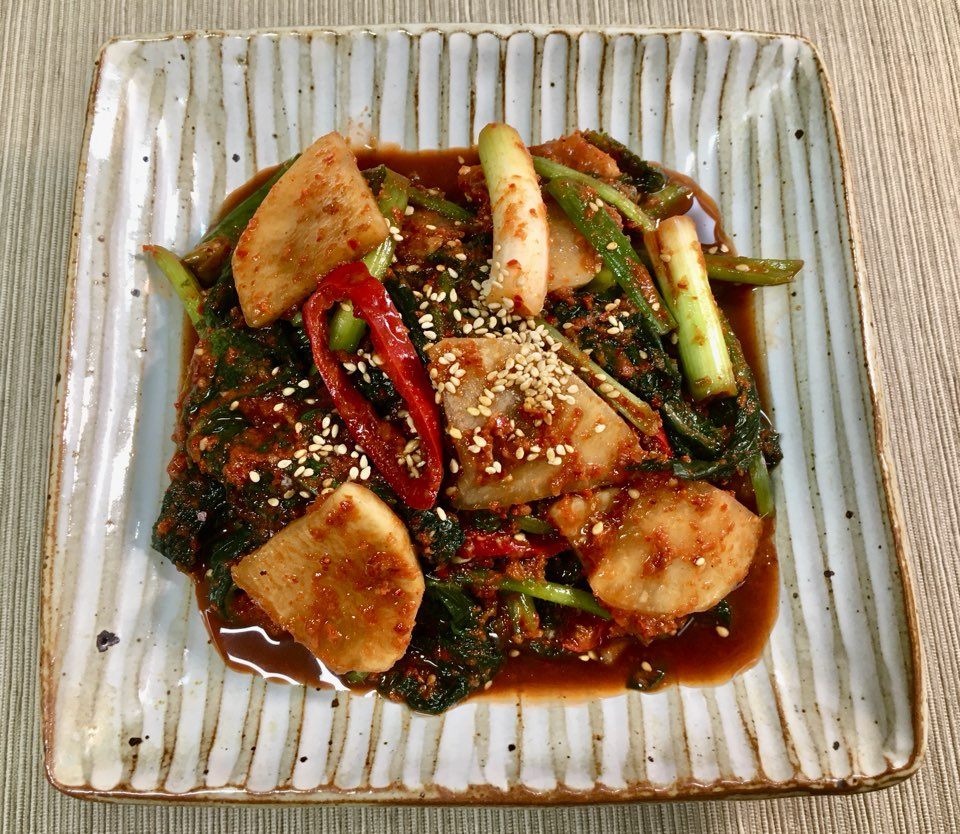Spicy and Deep Flavored Mustard Leaf Kimchi (Jeolla-do Style)
How to Make Authentic Jeolla-do Style Mustard Leaf Kimchi: The Secret to Deep Umami with Brewed Myeolchi-jeot

This recipe introduces the authentic Jeolla-do style mustard leaf kimchi, made with the unique spicy and fragrant flavor of ‘Hong-gat’ (red mustard greens). By brewing ‘myeolchi-jeot’ (fermented anchovy sauce) ourselves, we achieve a deep and rich umami flavor. The freshness of the mustard leaves combined with the profound taste of myeolchi-jeot makes this a truly addictive side dish!
Main Ingredients- 2 bunches Hong-gat (red mustard greens)
- 1/2 medium radish
- 2 red chili peppers
- 7-10 stalks green onions
Kimchi Seasoning- 2 cups Gochugaru (Korean chili flakes)
- 1 cup Fish sauce (anchovy or sand lance)
- 1/3 cup Saeujeot (fermented salted shrimp)
- 1 cup whole garlic cloves (minced)
- 2 cloves ginger (minced)
- 1 medium onion
- 2 Tbsp Fish sauce (for boiling myeolchi-jeot)
- 2 Tbsp Maesilcheong (plum extract)
For Salting- 1 cup Coarse sea salt
Rice Paste- 1 Tbsp Glutinous rice flour
- 1 cup Water
Boiling Myeolchi-jeot- 1 cup Myeolchi-jeot (fermented anchovy sauce)
- 1 cup Water
- 1 Tbsp Coarse sea salt
- 2 cups Gochugaru (Korean chili flakes)
- 1 cup Fish sauce (anchovy or sand lance)
- 1/3 cup Saeujeot (fermented salted shrimp)
- 1 cup whole garlic cloves (minced)
- 2 cloves ginger (minced)
- 1 medium onion
- 2 Tbsp Fish sauce (for boiling myeolchi-jeot)
- 2 Tbsp Maesilcheong (plum extract)
For Salting- 1 cup Coarse sea salt
Rice Paste- 1 Tbsp Glutinous rice flour
- 1 cup Water
Boiling Myeolchi-jeot- 1 cup Myeolchi-jeot (fermented anchovy sauce)
- 1 cup Water
- 1 Tbsp Coarse sea salt
- 1 Tbsp Glutinous rice flour
- 1 cup Water
Boiling Myeolchi-jeot- 1 cup Myeolchi-jeot (fermented anchovy sauce)
- 1 cup Water
- 1 Tbsp Coarse sea salt
Cooking Instructions
Step 1
Trim the root ends of the fresh red mustard greens. If the leaves are long, do not cut them; they will be used whole for their characteristic flavor and texture. Gently rinse them under water.

Step 2
Lightly wet the prepared mustard greens and then sprinkle coarse sea salt evenly between the leaves and stems. Let them salt for about 1 hour. Since the leaves are tender, over-salting can make them mushy. One hour is sufficient.

Step 3
Peel the radish and slice it into thin, bite-sized pieces (about 0.5 cm thick, ‘nabak’ style). Salt the radish pieces for about 30 minutes, then squeeze out excess water thoroughly. Adding radish to kimchi gives it a beautiful color as it absorbs the kimchi brine and adds a refreshing coolness.

Step 4
Slice the red chili peppers diagonally (about 0.5 cm thick). Cut the green onions into 3-4 cm lengths.

Step 5
In a pot, combine 1 cup of myeolchi-jeot, 1 cup of water, and 1 tablespoon of coarse sea salt. Bring to a rolling boil over high heat. Boiling the myeolchi-jeot with water and salt helps to eliminate any fishy odor and enhance its savory depth.

Step 6
Once boiling, strain the myeolchi-jeot mixture through a fine-mesh sieve or cheesecloth to remove bones and solids, keeping only the clear broth. This step is crucial for a smooth seasoning paste. Discard the strained solids.

Step 7
Make a rice paste by mixing 1 tablespoon of glutinous rice flour with 1 cup of water in a saucepan. Cook over low heat for about 5 minutes, stirring constantly, until it thickens. Let it cool completely. The rice paste adds body to the kimchi seasoning and helps it adhere to the ingredients.

Step 8
In a blender, combine 1 cup of whole garlic cloves, minced ginger (from 2 cloves), 1/3 cup of fermented salted shrimp, 1 peeled onion, and a small amount of water. Blend until the mixture is smooth. (Adding a bit of apple can also be a nice touch).

Step 9
In a large bowl, combine the blended seasoning base (from step 7) with 2 cups of gochugaru, the strained myeolchi-jeot broth, the cooled rice paste, 1 cup of fish sauce, and 2 tablespoons of maesilcheong. Mix everything thoroughly until you have a well-incorporated kimchi seasoning paste.

Step 10
Rinse the salted mustard greens thoroughly under cold running water several times to remove excess salt. Squeeze out as much water as possible; excess water can dilute the flavor. Have the squeezed radish ready as well.

Step 11
In a large mixing bowl, place the drained mustard greens. Add about two-thirds of the kimchi seasoning and gently mix it into the greens, ensuring an even coating. Once the greens are partially coated, add the squeezed radish and the remaining seasoning. Mix carefully to avoid bruising the ingredients. It’s recommended to make a generous amount of seasoning; any leftovers can be used in kimchi stews or spicy fish stews.

Step 12
Finally, add the chopped green onions and sliced red chili peppers, along with a sprinkle of sesame seeds. Gently toss everything together to finish the mustard leaf kimchi. The colorful additions enhance the visual appeal and add a pleasant crunch.

Step 13
The finished kimchi can be enjoyed immediately, but for a deeper flavor, let it sit at room temperature for about a day to ferment slightly. Afterward, store it in the kimchi refrigerator at a low temperature to allow it to mature slowly.




